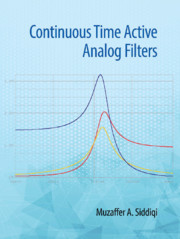Book contents
- Frontmatter
- Dedication
- Contents
- Preface
- Acknowledgments
- 1 Analog Filter: Concepts
- 2 First-and Second-order Filters
- 3 Magnitude Approximations
- 4 Delay: Approximation and Optimization
- 5 Frequency and Impedance Transformations
- 6 Sensitivity of Active Networks
- 7 Single Amplifier Second-order Filters
- 8 Multi Amplifier Second-order Filter Sections
- 9 Direct Form Synthesis: Element Substitution and Operational Simulation
- 10 Cascade Approach: Optimization and Tuning
- 11 Amplification and Filtering in Biomedical Applications
- 12 Audio Signal Processing and Anti-aliasing Filters
- 13 Follow the Leader Feedback Filters
- 14 Switched Capacitor Circuits
- 15 Operational Transconductance Amplifier-C Filters
- 16 Current Conveyors and CDTA (Current Differencing Transconductance Amplifiers) Based Filters
- 17 Active R and Active C Filters
- Index
- References
7 - Single Amplifier Second-order Filters
Published online by Cambridge University Press: 24 December 2019
- Frontmatter
- Dedication
- Contents
- Preface
- Acknowledgments
- 1 Analog Filter: Concepts
- 2 First-and Second-order Filters
- 3 Magnitude Approximations
- 4 Delay: Approximation and Optimization
- 5 Frequency and Impedance Transformations
- 6 Sensitivity of Active Networks
- 7 Single Amplifier Second-order Filters
- 8 Multi Amplifier Second-order Filter Sections
- 9 Direct Form Synthesis: Element Substitution and Operational Simulation
- 10 Cascade Approach: Optimization and Tuning
- 11 Amplification and Filtering in Biomedical Applications
- 12 Audio Signal Processing and Anti-aliasing Filters
- 13 Follow the Leader Feedback Filters
- 14 Switched Capacitor Circuits
- 15 Operational Transconductance Amplifier-C Filters
- 16 Current Conveyors and CDTA (Current Differencing Transconductance Amplifiers) Based Filters
- 17 Active R and Active C Filters
- Index
- References
Summary
Introduction
Depending on the specifications, the required order of the filter may be small or big. For less challenging requirements, a second-order or even a first-order section may be adequate. However, higher-order sections may become necessary in other situations. For higher-order filter requirements, either the direct form approach is used, or a combination of secondorder second sections is used which are connected in a cascade form or in a multiple-loop feedback form. Hence, the study of and realization methods of second-order sections assumes importance as they are used either stand-alone or form the building blocks for higher-order filters. Since the overall performance of the higher-order filter depends on the individual second-order building blocks, it is very important that these building blocks have desirable and attractive properties; the following are some such requirements.
(c) Low sensitivities of the two important filter parameters, pole frequency wo and pole-Q, with respect to the circuit elements are highly desirable.
(d) Utilization of a lesser number of passive elements (active elements as well, though in present discussion, it is assumed that only one active component is used) makes the realization economical in discrete, as well as in integrated form.
(e) Values of the passive components should be in the practical range of integrated circuit (IC) fabrication, and the component spread is preferred to be as small as possible in order to make them attractive in IC form.
(f) Independent tunability of the parameters wo and Q is important as analog filters require some tuning.
(g) To properly connect the second-order blocks in cascade or in multiple feedback system, their input impedance should be as high as possible and the output impedance as low as possible at all working frequencies. Otherwise, it can change the characteristics of the overall higher-order filter.
A large number of second-order active building blocks are available with each one claiming advantages over the others. Study of the development procedure of such sections might help the readers to gain more insight towards selecting the optimal section or help in designing new circuits/improving upon the existing ones.
Hence, we begin the study of development of second-order sections using a single passive feedback in Section 7.2; the effect of using different types of passive structures in the feedback is also included.
- Type
- Chapter
- Information
- Continuous Time Active Analog Filters , pp. 170 - 212Publisher: Cambridge University PressPrint publication year: 2020



